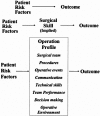Systems approaches to surgical quality and safety: from concept to measurement
- PMID: 15024308
- PMCID: PMC1356252
- DOI: 10.1097/01.sla.0000118753.22830.41
Systems approaches to surgical quality and safety: from concept to measurement
Abstract
Objective: This approach provides the basis of our research program, which aims to expand operative assessment beyond patient factors and the technical skills of the surgeon; to extend assessment of surgical skills beyond bench models to the operating theater; to provide a basis for assessing interventions; and to provide a deeper understanding of surgical outcomes.
Summary background data: Research into surgical outcomes has primarily focused on the role of patient pathophysiological risk factors and on the skills of the individual surgeon. However, this approach neglects a wide range of factors that have been found to be of important in achieving safe, high-quality performance in other high-risk environments. The outcome of surgery is also dependent on the quality of care received throughout the patient's stay in hospital and the performance of a considerable number of health professionals, all of whom are influenced by the environment in which they work.
Methods: Drawing on the wider literature on safety and quality in healthcare, and recent papers on surgery, this article argues for a much wider assessment of factors that may be relevant to surgical outcome. In particular, we suggest the development of an "operation profile" to capture all the salient features of a surgical operation, including such factors as equipment design and use, communication, team coordination, factors affecting individual performance, and the working environment. Methods of assessing such factors are outlined, and ethical issues and other potential concerns are discussed.
Figures
References
-
- Thomas EJ, Brennan T. Errors and adverse events in medicine: an overview. In: Vincent CA, ed. Clinical Risk Management. Enhancing Patient Safety. London: BMJ Publications; 2001:31–44.
-
- Healey MA, Shackford SR, Osler TM, et al. Complications in surgical patients. Arch Surg. 2002;137:611–618. - PubMed
Publication types
MeSH terms
LinkOut - more resources
Full Text Sources



